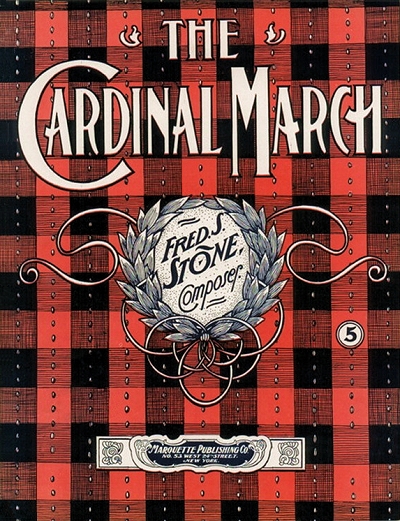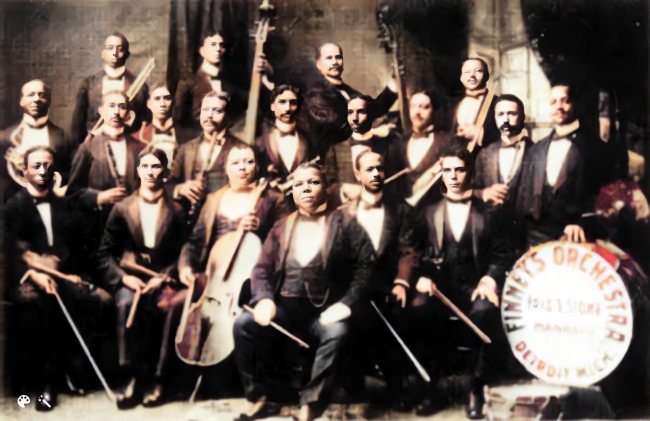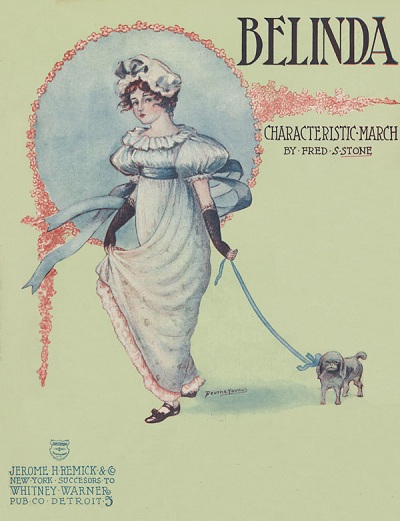|
Frederick St. Clair Stone (January 22, 1873 to January 14, 1912) | |
 Compositions Compositions | |
|
1891
The Detroit Wheelman's March1894
At Twilight (Des Aberds) Waltzes1895
The Indian: Two Step[w/Edward Liggett] 1896
La Albecite: Spanish WaltzesMackinac March 1897
A Lady of Quality (Waltzes)1898
The Cardinal MarchMa Ragtime Baby Ma Ragtime Baby (Song) [w/Charles H. Stone] 1899
The Bos'n Rag |
1900
Elseeta1901
Silks and Rags (Waltzes)1902
Sue1903
Belle of the PhilippinesA Kangaroo Hop 1905
Belinda1908
Melody at TwilightStone's Barn Dance 1909
Detroit Wholesalers and ManufacturersMarch and Two Step |
Fred S. Stone was a cross-border phenomenon in the music world, famous in both Detroit and central Canada. In fact, in spite of his dominance in music circles in early 20th century Detroit, Michigan, Stone was actually born in Chatham, Kent County, Ontario, making him Canadian by birth, and technically not African-American, although his parents originated in Georgia in the United States. He was the youngest of seven children born to Charles Stone and Susan Johnston. His many siblings included Agnes (1862), Washington (1864), Bella Jane (1865), Charles (1868), William (1869) and Cora Lee (1871).  While some sources have cited a birth year of 1874 or even 1875, the Canadian birth record stands as 1873. Fred's father remarried after his mother died, and in 1881 the family was shown living in London City, Ontario, around 60 miles from Detroit. Within a couple of years the family moved across the river into the Detroit area, and he even became a US citizen naturalized by his father's own acquired citizenship, Over the next decade or so, Fred often spent time over in Essex or Chatham, usually as a performer. In addition, Charles became a trombonist and William played trombone, tuba, bass and piano.
While some sources have cited a birth year of 1874 or even 1875, the Canadian birth record stands as 1873. Fred's father remarried after his mother died, and in 1881 the family was shown living in London City, Ontario, around 60 miles from Detroit. Within a couple of years the family moved across the river into the Detroit area, and he even became a US citizen naturalized by his father's own acquired citizenship, Over the next decade or so, Fred often spent time over in Essex or Chatham, usually as a performer. In addition, Charles became a trombonist and William played trombone, tuba, bass and piano.
 While some sources have cited a birth year of 1874 or even 1875, the Canadian birth record stands as 1873. Fred's father remarried after his mother died, and in 1881 the family was shown living in London City, Ontario, around 60 miles from Detroit. Within a couple of years the family moved across the river into the Detroit area, and he even became a US citizen naturalized by his father's own acquired citizenship, Over the next decade or so, Fred often spent time over in Essex or Chatham, usually as a performer. In addition, Charles became a trombonist and William played trombone, tuba, bass and piano.
While some sources have cited a birth year of 1874 or even 1875, the Canadian birth record stands as 1873. Fred's father remarried after his mother died, and in 1881 the family was shown living in London City, Ontario, around 60 miles from Detroit. Within a couple of years the family moved across the river into the Detroit area, and he even became a US citizen naturalized by his father's own acquired citizenship, Over the next decade or so, Fred often spent time over in Essex or Chatham, usually as a performer. In addition, Charles became a trombonist and William played trombone, tuba, bass and piano.Stone owed a lot of his early success to violinist Theodore Finney, sometimes referred to as "Old Man" Finney. Mr. Finney had done fairly well as an orchestra leader in the latter part of the 19th century in Detroit, and one of his star players was W. "Jack" Johnson, a cornetist. Johnson himself had been in the Detroit City Band with Finney, and then spent some time touring the south in the late 1880s with the Georgia Minstrels. When he returned, he started the Johnson Cornet Band which provided a training ground for many young black musicians in Detroit, including Stone who had come across the border by the mid-1890s with his brothers.
Fred started composing pieces for publication as early as 1891 when he was 18, including waltzes and dance numbers. He hit it big in 1898 with Ma Ragtime Baby, further increasing sales when his brother Charles added words for a song version. The following year he made a splash with Bos'n Rag. Between this and his considerable musicianship he quickly gained the respect of musicians throughout Detroit. During this time he married Rose Bush [yes, that was her actual name] on February 25, 1896, and she gave birth to Fred Jr. in May of 1898.
The Stone family was seen in Detroit for the 1900 enumeration with Fred listed as a musician. Charles is also listed in the same census as a musician, but William is difficult to locate in that record.
 |
In Stone's capacity as an arranger and leader in Finney's orchestra, the group became one of the earliest in the country to play ragtime. The old man did not favor this newer music, and whenever they played in some of the downtown establishments where ragtime was popular, he usually chose to not participate. Finney died in 1899, and very soon Stone took the group over by some acclaim from the members. He then hired a replacement for Finney, violinist Benjamin Shook. While the two co-conducted the orchestra mutually for some time, eventually they ended up in court deciding who would be able to use the well-established Finney name for the groups each of them ended up leading, with Shook finally taking the prize. Stone continued to lead his own groups, and recorded several pieces of ragtime and other genres for some of the earliest popular records. A few his own compositions were also recorded by other groups, including the Edison Concert Band who played Belle of the Philippines.
Finally Stone led (perhaps even helped to start) the black musicians union in Detroit.  They became powerful and popular enough that they were in the unusual position of being petitioned by white musicians in town for membership just so those players could get work. The organization and original building were still in use 50 years later. During this period he also turned out a number pieces that were as intriguing and varietal as that of one of his Detroit counterparts, Harry P. Guy, including a lovely set of waltzes titled Silks and Rags, and a lively almost-rag title, Belinda. He was so busy with the union and playing engagements that little was composed or published after that time, perhaps only existing as band arrangements.
They became powerful and popular enough that they were in the unusual position of being petitioned by white musicians in town for membership just so those players could get work. The organization and original building were still in use 50 years later. During this period he also turned out a number pieces that were as intriguing and varietal as that of one of his Detroit counterparts, Harry P. Guy, including a lovely set of waltzes titled Silks and Rags, and a lively almost-rag title, Belinda. He was so busy with the union and playing engagements that little was composed or published after that time, perhaps only existing as band arrangements.
 They became powerful and popular enough that they were in the unusual position of being petitioned by white musicians in town for membership just so those players could get work. The organization and original building were still in use 50 years later. During this period he also turned out a number pieces that were as intriguing and varietal as that of one of his Detroit counterparts, Harry P. Guy, including a lovely set of waltzes titled Silks and Rags, and a lively almost-rag title, Belinda. He was so busy with the union and playing engagements that little was composed or published after that time, perhaps only existing as band arrangements.
They became powerful and popular enough that they were in the unusual position of being petitioned by white musicians in town for membership just so those players could get work. The organization and original building were still in use 50 years later. During this period he also turned out a number pieces that were as intriguing and varietal as that of one of his Detroit counterparts, Harry P. Guy, including a lovely set of waltzes titled Silks and Rags, and a lively almost-rag title, Belinda. He was so busy with the union and playing engagements that little was composed or published after that time, perhaps only existing as band arrangements.At some point during the decade, Fred Jr. and two other of Rose's children died had died between 1897 and 1910, as indicated in the 1910 census. However, the Stones did have one surviving daughter, Laraine, in 1905. Around that time he became a member of the elite Iroquois Club, which included all of the members of Finney's orchestra. Fred also was associated with the Knights of Pythias, the first fraternal order chartered by the United States Congress, and was active in the National League of Musicians. His 1909 work Detroit Wholesalers and Manufacturers March and Two Step was most likely a commissioned piece rather than a member contribution. The Stone family was shown in Detroit's third ward in the 1910 enumeration with Fred listed as a musician in an orchestra. Charles was also living in Detroit and listed as an orchestra musician. Tragedy struck two years later when Stone died in 1912 just short of his 39th birthday, the result of an accidental misstep when boarding a moving trolley car for a Sunday afternoon ride.
Rose Stone remarried a couple of years later to house painter Charles Madison, and was found with him and Laraine in Detroit in the 1920 census. Charles continued to play in Detroit orchestras as well, and appears in the 1920 and 1930 census records as an orchestra leader. William is difficult to locate, and may have gone back to Canada. Laraine eventually married Mr. B.D. Henderson and moved to Little Rock, Arkansas. According to a May 1929 letter discovered by Mike Montgomery, she requested copies of her father's music from Remick in exchange for promotion of their stock in their movie theater. If there was a reply it is unknown. However, since the Remick company had been sold about this time, and soon was resold to Warner Brothers, it is potentially unlikely that this request was acted on. Fred Stone's contributions to ragtime performance and music in general in what would become the city of "Motown" were significant, and even may have prompted Harry P. Guy's comment that "you might almost say that Ragtime was born in Detroit." Not quite, but it certainly did thrive there for a good amount of time.
The previously unpublished information on Stone's early years in Canada and his birth name and date was researched by the author. The date and cause of death was uncovered by Michigan researcher, the late Mike Montgomery. Some additional facts were provided by California researcher, the late Nan Bostick, and a Ragtime Ephemeralist article. The remainder is from public records, newspapers and common biographical sources.